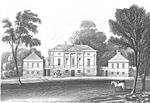Gidea Park Sports Ground
1948 establishments in EnglandBuildings and structures in the London Borough of HaveringCricket grounds in EssexCricket grounds in LondonEnglish cricket ground stubs ... and 5 more
Essex County Cricket ClubLondon sports venue stubsSport in the London Borough of HaveringSports venues completed in 1948Use British English from February 2023

Gidea Park Sports Ground is a cricket ground in Gidea Park, Romford, England. The first recorded match on the ground was in 1948, when the Essex Second XI played the Sussex Second XI in the Minor Counties Championship.Essex played their first first-class match there in 1950, when they played Hampshire. From 1950 to 1968 the ground played host to 34 first-class matches, the last of which saw Essex play Surrey.In local domestic cricket, the ground is the home venue of Gidea Park and Romford Cricket Club who play in the Essex Premier League.
Excerpt from the Wikipedia article Gidea Park Sports Ground (License: CC BY-SA 3.0, Authors, Images).Gidea Park Sports Ground
Eastern Avenue East, London Gidea Park (London Borough of Havering)
Geographical coordinates (GPS) Address Nearby Places Show on map
Geographical coordinates (GPS)
| Latitude | Longitude |
|---|---|
| N 51.59198 ° | E 0.20858 ° |
Address
Eastern Avenue East
Eastern Avenue East
RM2 5RA London, Gidea Park (London Borough of Havering)
England, United Kingdom
Open on Google Maps








